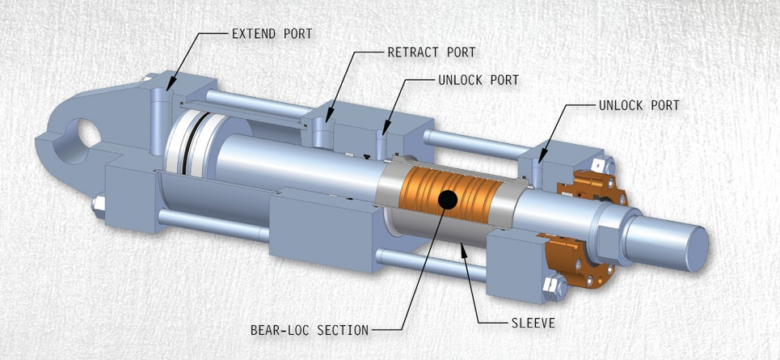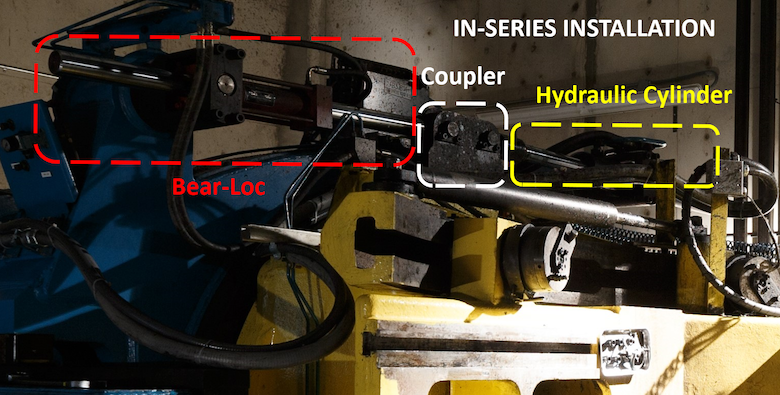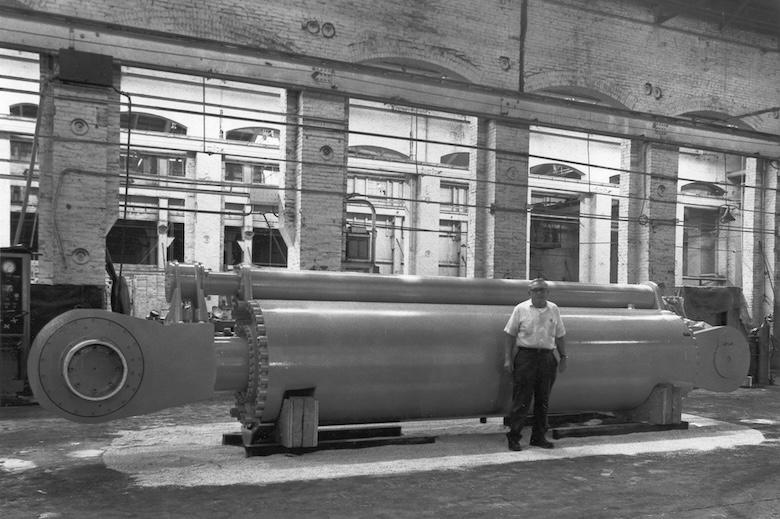Fluid power engineers are familiar with hydraulic load-holding or counterbalance valves that prevent sudden load drops and control descent speed. Such valves ensure smooth, stable operation and provide a safety mechanism in mobile and industrial machinery. The downside is they can fail due to wear, incorrect positioning, or failures in the hydraulic system. Pennsylvania-based York Precision Machining and Hydraulics thought outside the box on this one and developed the Bear-Loc fail-safe locking device as an alternative solution to prevent catastrophes.

“We’ve seen applications with very high load-holding requirements — a million pounds or several hundred thousand pounds. There was a company with barges that needed to ensure they didn’t have leakage or lose some of their payload, which could be hazardous to the environment. [They needed] something more fail-safe and certain than valving,” said Dan Baker, president of York Precision. “Sometimes it’s the performance aspect, but sometimes it’s the risk mitigation, where the risk of something happening catastrophically is so important that they don’t want to leave it to chance or a valve that could fail or wear over time. They want something that they know is going to work.”
For example, drilling rigs, coal crushers, cranes, excavators, and aerial lifts need reliable lockout capabilities to protect workers and equipment during emergencies and routine maintenance.
“Most companies out there use valving to hold these loads … that’s not your best option. Because they can fail, and when they fail, they fail in an unsafe way. The idea of a Bear-Loc is that if a hydraulic line breaks, if something goes wrong elsewhere in the system, the Bear-Loc is going to be there, and it’s going to hold on,” said John Ciardullo, engineering manager at York Precision.
The mechanism is simple and comprises a rod and a sleeve. When hydraulic pressure is applied, the sleeve expands around the rod, allowing the rod to move freely. When hydraulic pressure is removed — intentionally or accidentally — the sleeve immediately forms an interference fit around the rod, locking it into place.
“There are basically three factors of the Bear-Loc. The first factor is the pressure you use to unlock the lock. The second one is the diameter you’re locking against, and the third is the length of the lock. Different combinations of those will give us all kinds of lock capacities,” said Rob Tafel, engineering manager at York Precision. “We can play with the lengths, too, because sometimes [customers] have more space around it, but they don’t have a lot of length. So, if we go up in size and possibly even pressure, we can shorten the lock length to fit it within the space.”
When space constraints pose a challenge, especially in retrofit applications, a Bear-Loc can run in parallel or series with existing hydraulic actuators. This negates the need to change the hydraulic cylinders while still locking at any position.

Unlocking the Bear-Loc requires little fluid displacement — a mere few cubic inches. The device requires an independent hydraulic line and can integrate into a centralized system or use a separate supply.
“We tell people, for a 3,000 psi Bear-Loc, you need to get 3,000 psi into that lock. If it’s at 2,000, it’s not open. If it’s at 1,000, it’s not open,” said Ciardullo. “If they want to connect to the same reservoir and have the same pump, they can use different valves to get the fluid to and from the Bear-Loc. It’s really versatile in that way. They can do it however they wish … there’s a lot of different ways you can line it up.”
As an R&D project, the company is working on a design without an independent hydraulic line to the lock section. This would benefit engineers lacking a third line in a retrofit application. With this new design, engineers would use their extend and retract lines and add valves to automatically lock or unlock the cylinder based on the extending or retracting pressure.
The current design has been long proven in defense applications focused on performance and reliability. Offshore applications are also gaining traction.
“When a customer needs to get that load holding, but it’s not easily accessible by a person — whether it’s fully submerged or there’s an island in Alaska where they need to have a reliable solution, and it needs to work for a long period of time without human intervention — we’re seeing traction there,” said Baker. “We can make the Bear-Loc for maritime or submerged conditions. We’re also in industrial settings, such as presses, and we’re seeing some more wind power, which dovetails a bit with offshore.”
The company has also received inquiries from aerospace companies such as SpaceX, especially for launching applications.
“We have a history of 50 years of these things being out in the field and working,” said Ciardullo. “This is not an unproven product. We’re not in the baby stages. This thing’s been around for a long time and has held loads up to four million pounds without a problem.”

Surprisingly, the device remains relatively unknown despite its market longevity and field validation. Engineers tend to find out about Bear-Loc while searching for a solution they’re not sure exists.
“They have this uneasiness or just don’t feel like their design is where it needs to be from that risk mitigation or performance perspective,” said Baker. “Once we share how our product works, how long it can work without needing repairs, and that it’s a straightforward design, they catch on quickly. It’s not like it has a level of complexity. It’s not hard to comprehend. Yes, it’s difficult to manufacture, but people can grasp the concept relatively quickly. We get a good deal of excitement from the engineers.”
York Precision Machining and Hydraulics
yorkpmh.com/products/bear-loc
Filed Under: Components Oil Coolers, Featured, Mobile Hydraulic Tips, Safety